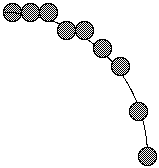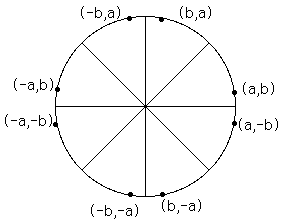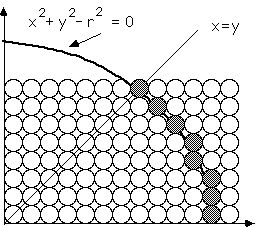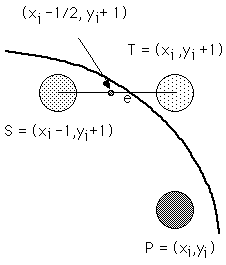
Since the equation for a circle on radius r centered at (0,0) is
x2 + y2 = r2,
an obvious choice is to plot
y = +- SQRT (r2 - x2)
as -r <= x <= r, This works, but is inefficient because of the multiplications and square root operations. It also creates large gaps in the circle for values of x close to R.

A better approach, which is still inefficient but avoids the gaps is to plot
x = r cos 0
y = r sin 0
as 0 takes on values between 0 and 360 degrees.
We only need to calculate the values on the border of the circle in the first octant. The other values may be determined by symmetry. Assume a circle of radius r with center at (0,0).

Procedure Circle_Points(x,y: Integer);
Begin
Plot(x,y);
Plot(y,x);
Plot(y,-x);
Plot(x,-y);
Plot(-x,-y);
Plot(-y,-x);
Plot(-y,x);
Plot(-x,y)
End;
Consider only the first octant of a circle of radius r centered on the origin. We begin by plotting point (r,0) and end when x < y.

The decision at each step is whether to choose the pixel directly above the current pixel or the pixel which is above and to the left (8-way stepping).
Assume Pi = (xi, yi) is the current pixel.
Ti = (xi, yi + 1) is the pixel directly above
Si = (xi - 1, yi + 1) is the pixel above and to the left

f(x ,y) = x2 + y2 - r2 = 0
f(xi - 1/2 + e, yi + 1) = (xi - 1/2 + e)2 + (yi + 1)2 - r2 = 0
= (xi - 1/2)2 + (yi + 1)2 - r2 + 2*(xi - 1/2)*e + e2
= f(xi - 1/2, yi + 1) + 2*(xi - 1/2)*e + e2
= 0
Let di = f(xi - 1/2, yi + 1) = -2*(xi - 1/2)*e - e2
if e < 0 then di > 0 so choose point S = (xi - 1, yi + 1).
di+1 = f(xi - 1 - 1/2, yi + 1 + 1)
= ((xi - 1) - 1/2)2 + ((yi + 1) + 1)2 - r2
= di + 2*(yi+1 - xi+1 ) + 1
if e >=0 then di <=0 so choose point T = (xi, yi + 1).
di+1 = f(xi - 1/2, yi +1 +1)
= di + 2*yi+1 + 1
The initial value of di is
do = f(r - 1/2, 0 + 1)
= (r - 1/2)2 + 12 - r2
= 5/4 - r {1-r can be used if r is an integr }
When point S = (xi - 1, yi + 1) is chosen then
di+1 = di + -2*xi+1 + 2*yi+1 + 5
When point T = (xi, yi + 1) is chosen then
di+1 = di + 2*yi+1 + 3
Begin {Circle}
x := r;
y := 0;
d := 1 - r;
Repeat
Circle_Points(x,y);
y := y + 1;
if d < 0 Then
d := d + 2*y + 1
Else Begin
x := x - 1;
d := d + 2*(y-x) + 1
End
Until x < y
End; {Circle}
From Graphica -- see details 4.12.1996